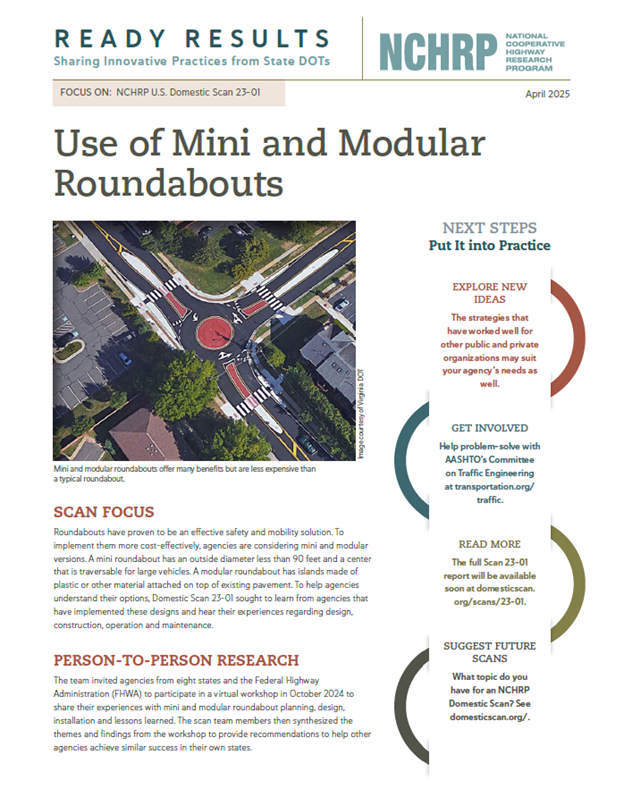Original Scope: Since being first introduced to U.S. practice in the 1990s, roundabouts have proven to provide for safer, more efficient movement of vehicles through an intersection and to provide better pedestrian service by limiting the direction of vehicle movement. Design and construction of roundabouts may require additional costs to an owner due to impacts such as additional right of way and utility relocation costs that may not be necessary for intersections with lower traffic volumes. For such situations, innovative agencies have developed the concept of mini roundabouts and modular roundabouts that can be built within the existing right of way for certain situations.
The objective of the scan is to describe the experiences and lessons learned from leading states that may be valuable to others considering using mini or modular roundabouts. The scan team will meet with innovative agencies that have utilized mini and / or modular roundabouts and discuss their experiences in design, construction, operation, and maintenance.
This scan is being planned as a virtual peer exchange. The scan will compile effective practices and lessons learned by contributing agencies that can comprise a “toolbox” of resources. Agencies seeking to build mini and modular roundabouts on their systems can adapt the toolbox for their own use.
Implementation and Impact
On June 8th, at the 2025 International Conference on Roundabouts and Geometric in Atlanta, Georgia, Joe Hummer (NCDOT) and Laura Nesbitt (Jacobs) presented a 4-hour workshop for 70 attendees.
Joe Hummer (NCDOT) and Laura Nesbitt (Jacobs) presented a webinar on the scan results for ITE on February 6, 2025 to an audience of 300 people.
On December 1st, 2025, Joe Hummer (NCDOT) and Zach Bugg (Kittleson) will present the scan results at the Caltrans Peer Exchange Training Forum & Workshop on Small, Affordable and Quick Build Roundabout Alternatives.
Scan chair, Joseph Hummer, provided perspectives on the scan outcomes:
Scan Members
- Joseph E. Hummer, North Carolina DOT, Scan Chair
- William Lambert, New Hampshire DOT
- Laura Nesbitt, Georgia DOT (Retired)
- Garrett Dawe, Michigan DOT
- Gwen Mei, Minnesota DOT
- Mark Andrew Gaines, Washington State DOT
- Hilary Isebrands, FHWA
- Anyesha Mookherjee, FHWA
- Zach Bugg, Kittelson & Associates, SME
Workshop Participants
- City of McKinney, TX
- City of San Diego, TX
- Minnesota DOT
- North Carolina DOT
- Virginia DOT
- Washington State DOT
- Washtenaw County, MI
Please login to access additional content for scan members only.


